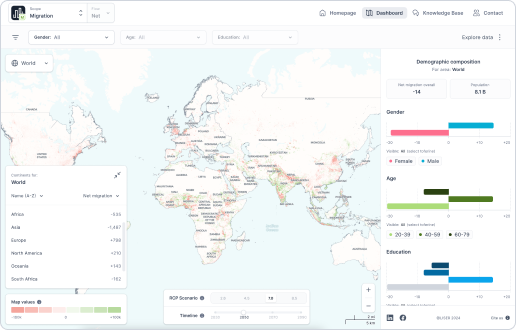The project is currently in the pilot phase, so some options may not be available. Share your feedback to help us improve.
Climate Change: Migration Economics
CliC:ME
TURN DATA INTO ACTION
CLIMATE MIGRATION DASHBOARD
Explore and use comprehensive data on climate change-driven migration, including its socio-economic impacts. Dive into interactive insights and conduct detailed analyses to understand how climate factors reshape migration patterns and affect communities worldwide.
Whether you are conducting in-depth research, informing policy decisions, supporting societal initiatives or seeking to understand how climate change affects your community, you are in the right place.
Explore the dashboard

Migration dynamics: the impact of climate change
Climate change is significantly affecting human migration. The CliC:ME dashboard provides comprehensive insights into how environmental shifts drive human mobility. Using high quality data, robust methodologies and interactive tools, CliC:ME reveals migration patterns influenced by rising sea levels, extreme weather events and heat exposure.

Resilience building: the impact of climate migration
Our dashboard explores the socio-economic impacts of climate change on migration, showing effects on economies, infrastructure and communities. It equips policymakers, researchers and global citizens with data to make informed decisions and foster resilience against climate change.
Start with CliC:ME
Explore detailed maps, charts and tables that highlight vulnerable regions and project future trends, all at a granular 5x5 km resolution.
Our goal is to bridge the gap between data and action, helping you to grasp the complexities of climate migration and its far-reaching effects.
Our dataset is shared via open access, enabling further research and collaboration. Dive in and discover how climate change is transforming human geography and the world economy, and what this means for the future of societies around the globe.
Explore the dashboard

Tangible outcomes
Uncover the power of our dashboard in action.
Senegal’s climate poverty and migration by 2050: the price of inaction
Explore how a 3°C global temperature rise leads to severe drops in living standards and increased migration movement in Senegal.
Discover the details
Coming Soon
2nd Case
Coming Soon
3rd Case
Dashboard application case study
Senegal’s climate poverty and migration by 2050: the price of inaction
Explore the potential effects of climate change on Senegal’s economy and population movements, using a spatially pixelated model of the world economy.
Climate change is projected to significantly influence human mobility in Senegal from 2030 to 2050 under the RCP7.0 scenario. Dakar will gain nearly 500,000 adults, with a gender imbalance (300,000 men vs. 200,000 women). Thies, Sedhiou and Louga will each gain 20,000 to 30,000 inhabitants, with Thies primarily attracting men. Kedougou and Matam will lose around 100,000 and 90,000 inhabitants, respectively, mostly men.
Net migration overall
-1,487
Population
35.6 M
Scroll down
or
Discover the details
Most migration will be across administrative regions, with local migration decreasing by 40,000 people and playing a minor role in climate-related movement.
Internationally, approximately 133,000 people will migrate — mainly to Italy, France and Spain — while 136,000 will choose to stay in Senegal, preferring immobility over moving to Mauretania and Gambia. Senegal will gain 47,000 people from Mauretania and lose a few thousand from Mali, Gambia and France. Overall, Senegal will gain 27,000 men but lose 23,000 women over this period.
Map values
-100k
0
+100k
Scroll down
or
Discover the details
Climate change will increase extreme poverty in Senegal by 2050, disproportionately affecting women and vulnerable regions.
In 2050, the RCP7.0 scenario projects an increase in extreme poverty in Senegal of 2 percentage points, adding 400,000 more adults living on less than $2.15 a day. Women are slightly more vulnerable, with a 2 percentage point increase (196,000 individuals), compared with a 1.87 percentage point rise for men (189,000 individuals). While Dakar, Diourbel and Thies will be minimally affected, Tambacounda, Kedougou and Kaffrine will see extreme poverty rates rise by 10.9 and 7 percentage points, respectively. These increases are notably higher than the averages for Africa (0.6 percentage points) and the world (1.1 percentage points, dominated by Asian countries).
Read the whole study
Our partners




Contact LISER
Luxembourg Institute of Socio-Economic
Research (LISER)
Maison des Sciences Humaines
11, Porte des Sciences
L-4366 Esch-sur-Alzette / Belval
E-mail: clicme@liser.lu
Tél.: (+352) 58 58 55 – 1
Technical problems?
The results published on this website by LISER have been generated using information, techniques, data, databases, algorithms, methodology, models, results, design, technology, material, inventions and/or software and any intellectual property rights (LISER’s background) as well as publicly available data, facts and information as detailed in our Knowledge Base. For the avoidance of doubt, LISER remains the sole owner of all LISER’s material, work, results and background.
The results of the project published by LISER on this website for dissemination of the knowledge, research and/or teaching purposes, may be accessed and used freely on an ‘AS IS’ basis, without any representation or warranty of any kind by LISER, either express or implied, including but not limited to any warranty or conditions of merchantability or fitness for any particular purpose.